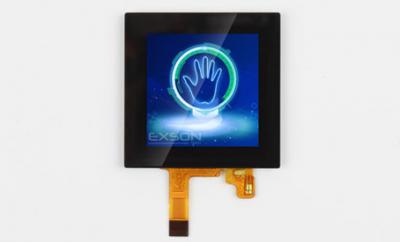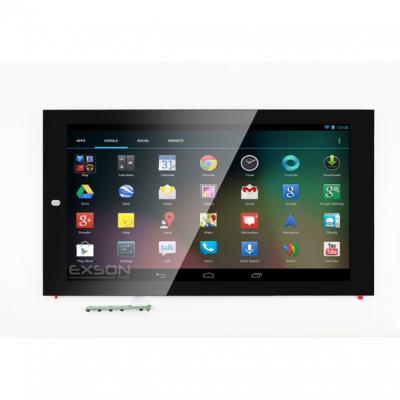Resistive touch screens were first invented in 1971 by Dr. Samuel G. Hurst. He calls the sensor the Elograph, after his company, Elographics.
As the name suggests, resistive touch LCD screens work by applying pressure to the LCD screen. A resistive touch screen consists of several thin layers. These layers consist of a glass panel on the bottom, followed by two resistive circuit layers coated with a thin conductive layer of metal such as ITO with a small gap of spaced dots in between.
When pressure is applied to the screen with a finger or stylus, the outer resistive layer is pushed against the inner layer. The two metal conductive layers come into contact, causing a return circuit and a change in resistance in the vertical and horizontal axes. This change is detected by sensors located on the edge of the screen, and then the exact position is found through horizontal and vertical coordinates to indicate the touch point.
1. The lowest production cost: Resistive touch screen is relatively easy to manufacture due to its simple structure, and the resistive touch screen cost is lower compared with other LCD touch technologies.
2. Any object can be activated: As mentioned above, any object that can exert pressure on the resistive touchscreen display will trigger a touch action and be detected by the resistive touch sensor. This characteristic makes resistive touchscreens the preferred choice in industrial and medical environments where operators may use gloves on LCD touchscreens.
3. Insensitivity to stray stimuli: The way resistive touch screens detect touch actions determines that liquid spills/snow or surface contaminants will not cause unexpected reactions on the touch screen, which is very important for industrial and outdoor environments.
4. No risk of glass shattering: Most LCD touch screen technologies use glass as the outer touch layer. This is usually not allowed in food and beverage facilities to avoid contamination from broken glass. Resistive touch screens use a tough polycarbonate outer layer that holds broken glass should the LCD screen break.
5. Low power consumption: Resistive touch screen consumes little power.
6. Not sensitive to EMI/RFI: The resistive touch screen detects the change of resistance to locate the coordinates of the touch. This is insensitive to EMI/RFI.
Resistive touch screens have been widely used for many years and are a proven and trusted solution for building human-machine interfaces.
 The Role of Touch Panel Modules in Modern DevicesJanuary 25, 2024In today's fast-paced world, technology plays a vital role in our everyday lives. From smartphones to tablets and even refrigerators, the integration of touch panel modules has revolutionized the ...view
The Role of Touch Panel Modules in Modern DevicesJanuary 25, 2024In today's fast-paced world, technology plays a vital role in our everyday lives. From smartphones to tablets and even refrigerators, the integration of touch panel modules has revolutionized the ...view Capacitive LCD Display: Touch InteractionAugust 13, 2024A capacitive LCD display is a display module that integrates capacitive LCD display technology with liquid crystal display technology. The capacitive LCD display uses a four-layer composite glass scre...view
Capacitive LCD Display: Touch InteractionAugust 13, 2024A capacitive LCD display is a display module that integrates capacitive LCD display technology with liquid crystal display technology. The capacitive LCD display uses a four-layer composite glass scre...view Introduction of the Applications of Medical LCD Display ScreenAugust 4, 2023In the hospital, we often see medical equipment, and most of the medical equipment is equipped with medical LCD display screens. So, do you know what the uses of LCD display screens in medical field a...view
Introduction of the Applications of Medical LCD Display ScreenAugust 4, 2023In the hospital, we often see medical equipment, and most of the medical equipment is equipped with medical LCD display screens. So, do you know what the uses of LCD display screens in medical field a...view What Are the Characteristics of LCD Display Panels?September 26, 2022Ⅰ. What are the characteristics of LCD display panels?1. The body is thin and space-saving: Compared with the bulky CRT display, the LCD display panel only needs one-third of the space of the former....view
What Are the Characteristics of LCD Display Panels?September 26, 2022Ⅰ. What are the characteristics of LCD display panels?1. The body is thin and space-saving: Compared with the bulky CRT display, the LCD display panel only needs one-third of the space of the former....view Illuminating the Display Frontier: An Introduction to TFT LCD TechnologyNovember 17, 2023In the dynamic landscape of visual technology, Thin-Film Transistor Liquid Crystal Display, better known as TFT LCD, emerges as a beacon of innovation, transforming the way we experience digital visua...view
Illuminating the Display Frontier: An Introduction to TFT LCD TechnologyNovember 17, 2023In the dynamic landscape of visual technology, Thin-Film Transistor Liquid Crystal Display, better known as TFT LCD, emerges as a beacon of innovation, transforming the way we experience digital visua...view The Role of Research and Development in TFT Module FactoryMay 9, 2024In the rapidly changing field of science and technology, TFT (thin film transistor) module factory not only faces the constant evolution of market demand, but also keeps up with the pace of technologi...view
The Role of Research and Development in TFT Module FactoryMay 9, 2024In the rapidly changing field of science and technology, TFT (thin film transistor) module factory not only faces the constant evolution of market demand, but also keeps up with the pace of technologi...view Call us on:
Call us on:  Email Us:
Email Us:  2F-M1 XiaWei Industrial Park, GuanLan, LongHua District, SZ, China
2F-M1 XiaWei Industrial Park, GuanLan, LongHua District, SZ, China